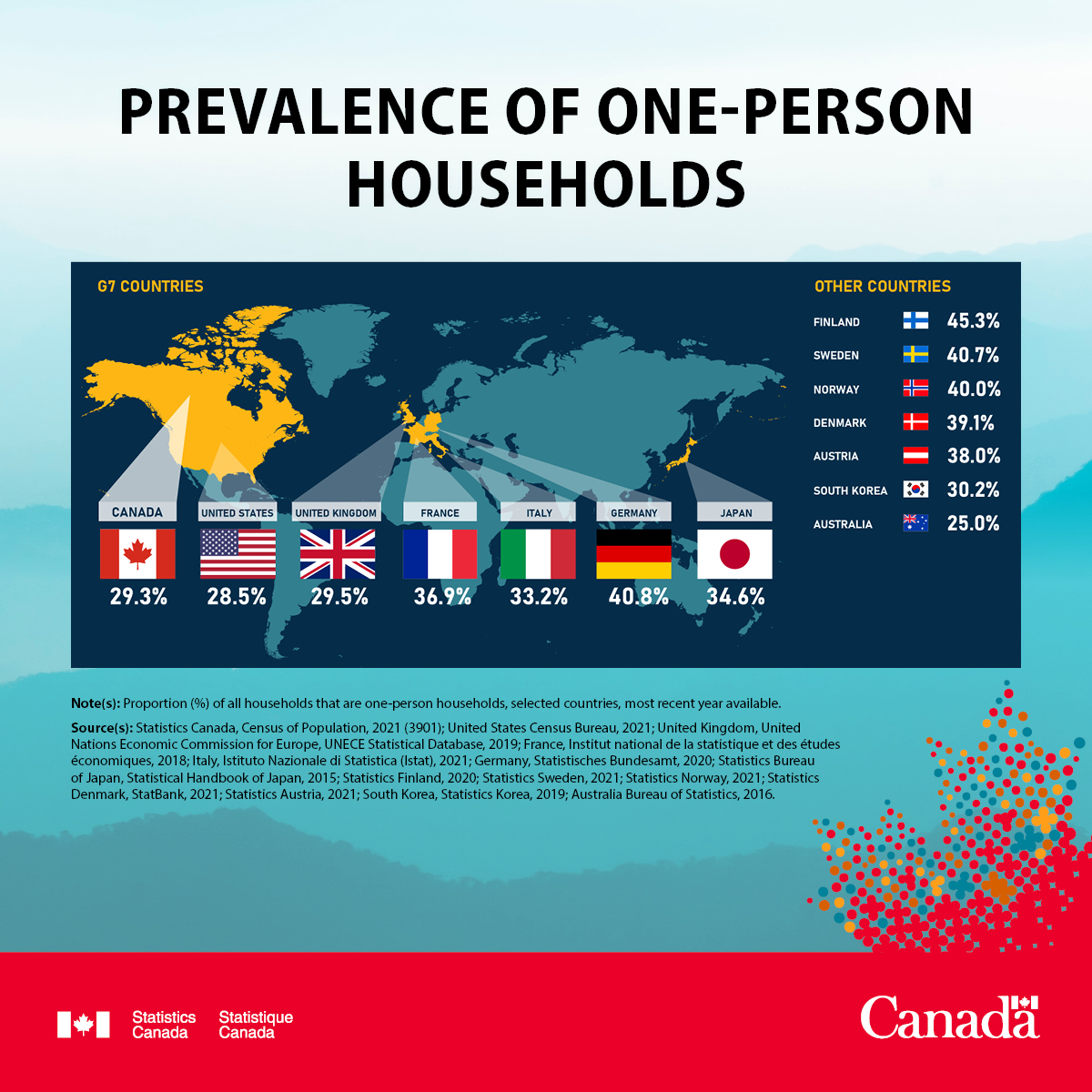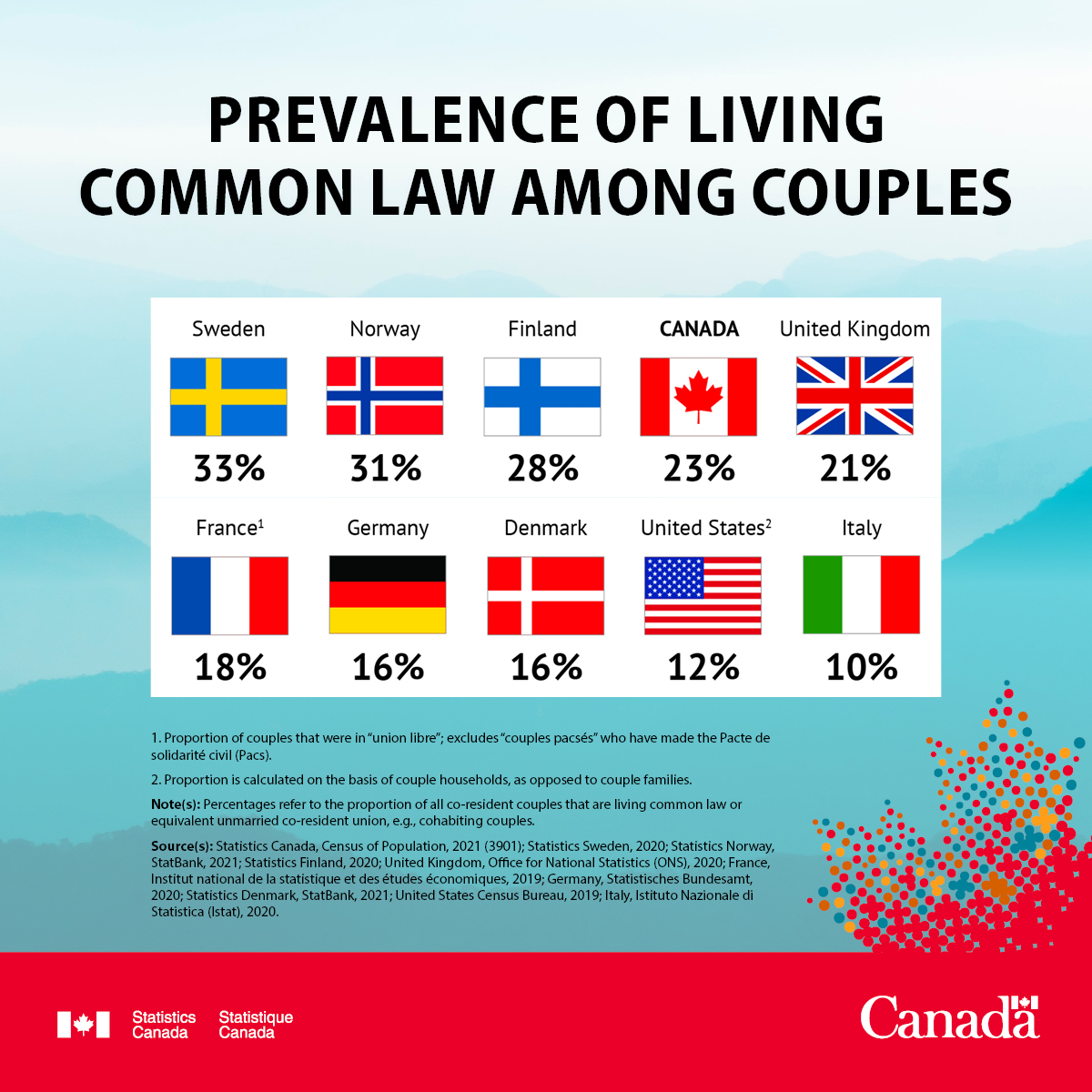Help spread the word about 2021 Census data on families, households and marital status in Canada. These data were released on July 13, 2022.
Quick facts
- Among G7 countries, Canada has the highest share of couples that are living common law (23%), owing to the popularity of this type of union in Quebec—home to 43% of Canada's common-law couples. Excluding Quebec, the share of common-law couples in Canada would have been 17% in 2021.
- Compared with previous generations, today's younger adults are less likely to be living as part of a couple—as alternatives like living alone, with roommates or with parents have become more common.
- In the 2021 Census, couples could be classified according to their gender diversity status the first time.
- The combined trends of population aging and decreasing fertility have resulted in fewer couples with children living at home with them.
- Households composed of roommates—that is, two or more people living together, among which none are part of a census family—are the fastest-growing household type.
- Households composed of roommates—that is, two or more people living together, among which none are part of a census family—are the fastest-growing household type.
- Continuing a long-term pattern of growth, 4.4 million people lived alone in 2021, up from 1.7 million in 1981. This represented 15% of all adults aged 15 and older in private households in 2021, the highest share on record.
Resources
- The Daily - State of the union: Canada leads the G7 with nearly one-quarter of couples living common law, driven by Quebec
- The Daily – Home alone: More persons living solo than ever before, but roomies the fastest growing household type
- Gender diversity status of couples: New information in the 2021 Census
- Focus on Geography Series, 2021 Census of Population
Social media content
Statistics Canada encourages our community supporters to:
- Share and amplify our social media content about the 2021 Census.
- Make your own posts with downloadable images and text.
Post 1

Alt text / description - Post 1 image
The title of the infographic is "Prevalence of one-person households"
This is a world map showing the proportion of all households that are one-person households among G7 countries and other countries (Finland, Sweden, Norway, Denmark, Austria, South Korea and Australia) in 2021 or the most recent year available.
Each G7 country is highlighted on the world map. Their names and flags are displayed as well as their proportions of one-person households: 29.3% for Canada, 28.5% for the United States, 29.5% for the United Kingdom, 36.9% for France, 33.2% for Italy, 40.8% for Germany and 34.6% for Japan.
The names and flags of other selected countries are also displayed along with their respective proportions of one-person households: 45.3% for Finland, 40.7% for Sweden, 40.0% for Norway, 39.1% for Denmark, 38.0% for Austria, 30.2% for South Korea and 25.0% for Australia.
Note(s): Proportion of all households that are one-person households, selected countries, most recent year available.
Source(s): Statistics Canada, Census of Population, 2021 (3901); United States Census Bureau, 2021; United Kingdom, United Nations Economic Commission for Europe, UNECE Statistical Database, 2019; France, Institut national de la statistique et des études économiques, 2018; Italy, Istituto Nazionale di Statistica (Istat), 2021; Germany, Statistisches Bundesamt, 2020; Statistics Bureau of Japan, Statistical Handbook of Japan, 2015; Statistics Finland, 2020; Statistics Sweden, 2021; Statistics Norway, 2021; Statistics Denmark, StatBank, 2021; Statistics Austria, 2021; South Korea, Statistics Korea, 2019; Australia Bureau of Statistics, 2016.
There were 4.4 million people in Canada living alone in 2021, up from 4.0 million in 2016. Learn more about newly released living arrangement data from the #2021Census: https://bit.ly/3AKIsRs
Post 2

Alt text / description - Post 2 image
The title of the infographic is "Prevalence of living common law among couples"
The infographic displays the national flags of a selection of 10 countries. Beneath each national flag, the proportion (%) of couples that are living common law is displayed, for the most recent year available, as follows: Sweden (33%), Norway (31%), Finland (28%), Canada (23%), United Kingdom (21%), France1 (18%), Germany (16%), Denmark (16%), United States2 (12%), Italy (10%).
- Proportion of couples that were in "union libre"; excludes "couples pacsés" who have made the Pacte de solidarité civil (Pacs).
- Proportion is calculated on the basis of couple households, as opposed to couple families.
Notes(s): Percentages refer to the proportion of all co-resident couples that are living common law or equivalent unmarried co-resident union, e.g., cohabiting couples.
Source(s): Statistics Canada, Census of Population, 2021 (3901); Statistics Sweden, 2020; Statistics Norway, StatBank, 2021; Statistics Finland, 2020; United Kingdom, Office for National Statistics (ONS), 2020; France, Institut national de la statistique et des études économiques, 2019; Germany, Statistisches Bundesamt, 2020; Statistics Denmark, StatBank, 2021; United States Census Bureau, 2019; Italy, Istituto Nazionale di Statistica (Istat), 2020.
Canada has the highest share of couples living common law among the G7. Check out how Canada compares to other countries in the most recent census data release: https://bit.ly/3PmaMOj
Post 3

Share the news on Instagram. Create your own Instagram story using this downloadable image. Don't forget to add census stickers by searching "2021 Census" in the stickers search bar.
Web images
Terms of use
See the Census engagement toolkits—Terms of use for information on the approved use of official wordmarks, identifiers and content.








